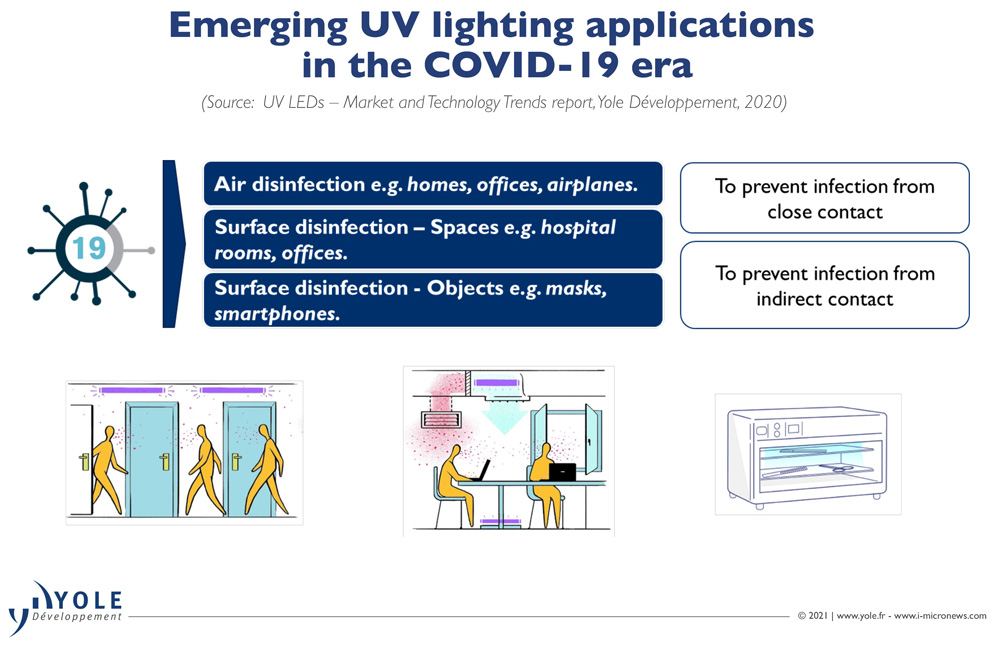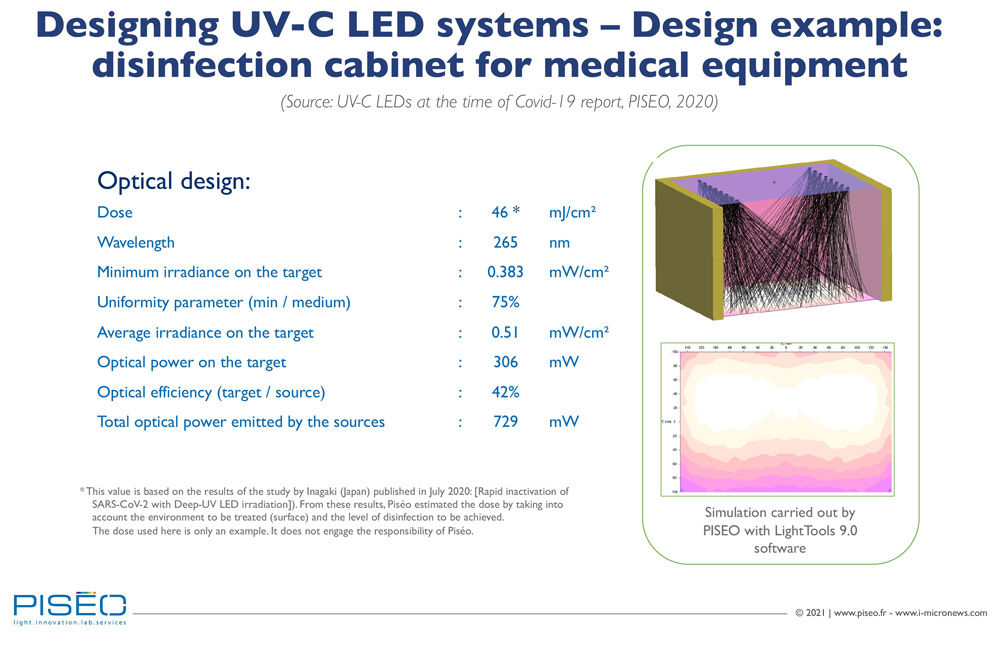News: Markets
15 February 2021
UV LEDs and coronavirus: how effective are the latest sanitizer systems?
Earlier this year, UV LED businesses Sensor Electronics Technology Inc of the USA and South Korean Seoul Viosys released a Violeds UV-C LED system that is reported to kill 99.437% of the SARS-CoV-2 virus in a second. Tests were conducted by South Korea-based KR Biotech with SETI and Seoul Viosys stating that the sanitizer device could be an effective method to disinfect airborne viruses as well as water systems and rooms housing Covid-19 patients. But how effective is the technology?
Photonics innovation services provider PISEO, which recently published a UV-C LED technical analysis report ‘UV-C LEDs at the time of Covid-19’ and has a heritage of system design and realization, believes that more public detail is required before industry players can truly know.
PISEO is a partner of market research & strategy consulting company Yole Développement. The firms have joined force to deliver an overview of the UV LED industry. With an analysis of the market trends and technology evolution, Yole’s analysts offer a complementary vision of the UV LED industry via the dedicated report ‘UV LEDs – Market and Technology Trends’.
Remarkable growth
The Violeds device comes at a time when the UV-C LED market is seeing unprecedented growth. The pandemic has triggered huge demand for disinfection systems, boosting momentum in UV-C LEDs. According to Yole’s UV LED report, the market is expected to more than double, from $144m in 2019 to $308m in 2020, before mushrooming to $2.5bn by 2025.
The rapid growth follows more than a decade of relatively slow market activity. Back in 2008, UV LEDs were beginning to emerge, with only 10 industry players largely focusing on UV-A LEDs for UV curing applications.
Over time, visible LED businesses joined the UV LED market, advancing product development. However, increased competition – coupled with technology challenges – saw the UV-C LED segment remain sluggish, with disinfection product demand being largely met by the market incumbent UV mercury lamp. Covid-19 is changing this, says Yole.

Despite its relatively high cost and low efficiency, the UV-C LED is now rapidly displacing the market share of UV mercury lamps for some key reasons. LEDs do not contain mercury (widely banned in many electrical and electronics products), while switching these devices on and off does not impact lifetime (as is the case with the UV lamp).
Importantly, the UV-C LED market now involves at least 95 industry players, including Crystal IS, Nitride Semiconductors, Nichia, Epitop, SemiLEDs, Seoul Viosys and Sensor Electronics Technology Inc (SETI). Some of these businesses – Nichia is the latest – have released data that indicates that UV-C LEDs can inactivate at least 99% of the SARS-CoV-2 virus on a surface, within seconds of exposure, signalling the that market is ready for Covid-19-fuelled growth. However, the replacement of the mercury lamp with the UV-C LED into an effective and safe product, as recently marketed by Seoul Viosys and SETI, is not trivial.
System design and integration challenges
The design of any UV-C LED disinfection system must be adapted to the UV-C LED’s specific properties, including optical emission and thermal management. Only limited lessons can be learned from the visible LED industry, as the much lower efficiency of the UV-C LED impacts thermal integration while UV-C radiation degrades the materials used in such systems, both of which will decrease the reliability of the end-product.
Product design must also take into account safety issues associated with radiation from UV-C LEDs. Energy emitted from these components is much higher intensity than normal sunlight, making UV-C LED disinfection systems a hazard to humans if technical safety standards are not followed. Indeed, the Global Lighting Association recently published guidance on the safety requirements of such products following, as it said: “the proliferation of UV-C disinfecting devices”.
At the same time, existing regulations only apply to safety, and have not yet been extended to the disinfection process of the latest systems. Indeed, no defined test process yet exists that would allow the performance of different products to be compared. For example, KR Biotech data indicates that the Violeds system can inactivate 99.457% of the SARS-CoV-2 virus in a second, but where is the detail on the test procedure or on influencing factors such as room-size and surface type?

Still, while the jury may be out on the latest UVC-LED systems, these early products will create more momentum in this fast-growing market, reckons the report. Right now, many industry players are looking to design and build UV-C LED disinfection systems, and the design, integration and test services from a photonics innovation center such as Piseo can ensure that the finished product is both effective and safe.









